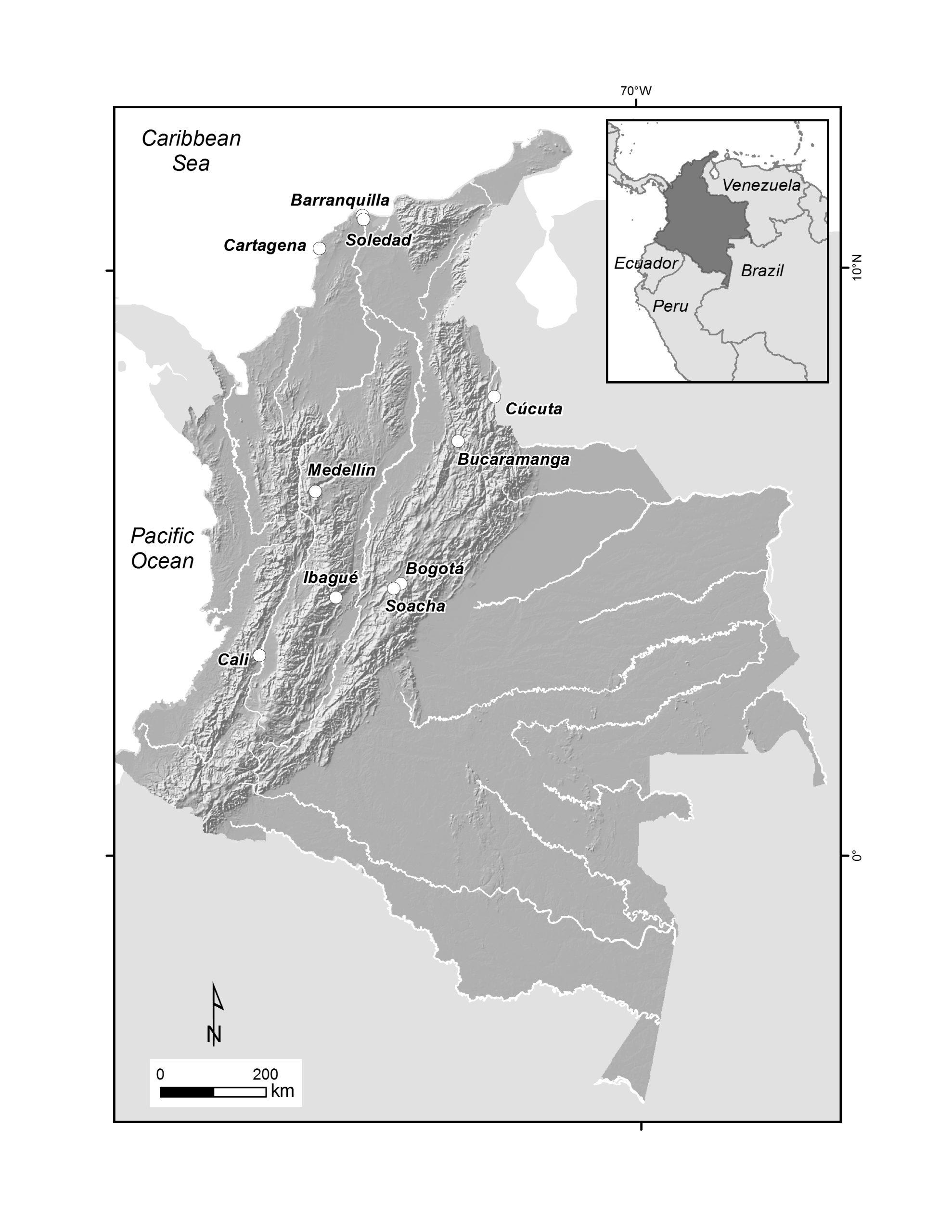51
Florian Koch, Helmholtz Centre for Environmental Research UFZ, Germany
Climate change confronts cities with the necessity not only to mitigate but also to adapt to a changing climate (Revi et al., 2014). How to implement adaptation as a policy goal and how to enforce it against other policy goals is a new task for cities and not quite clear. Research on these issues is lacking: “Most of the literature on climate change adaptation and cities is focusing on what should be done, not on what is being done (because too little is being done)” (UN-Habitat, 2011: 145). Much research sees adaptation as a problem-free process, which is capable of delivering positive outcomes and neglect the complexity of adaptation as a social process (Mimura et al., 2014). The question of how adaptation action can be included in every-day politics needs further investigation, especially in cities of the Global South. These cities merely have the capacity to provide the basic infrastructure for their inhabitants, but are forced to elaborate and implement costly adaptation measures, as the consequences of climate change are foremost visible there.
This article gives a short overview on how cities in Colombia have included climate adaptation in their political agendas. Evidence of climate change in Colombia is already visible: an annual loss of glacier areas of 3 to 5%, significant changes of rainfall patterns as an increasing frequency of extreme hydrometeorological phenomena, as well as a rising sea-level is stated (IDEAM, 2013). The country expects an increase in the average temperature of two degrees Celsius up to the end of the century (IDEAM, 2013).
In order to reveal how climate adaptation is included in urban politics, the so called “Development plans – planes de Desarrollo” of the nation´s 10 biggest cities were analyzed. Development plans determine the political agenda of a city and are issued by the respective mayor at the beginning of his term. Mayors are elected for four years without the possibility of an immediate reelection, therefore development plans have only a short/middle term perspective. Development plans contain the projects the mayor wants to implement during his term and are legally binding. Still, the analyses of the development plans has to be done with caution: The plans are political documents and even if climate adaptation is included in it, the implementation is not yet guaranteed – especially in Colombia with its weak public institutions and informal political practices (see for details Robinson 2013). But if the development plan contains no adaptation measures, then it is certain that the municipality won´t realize any form of adaptation strategy in this period. Therefore these plans can help to understand the role of adaptation in comparison to other political goals. The analyses of the current development plans (2012-2015 term) revealed some insights on the relationship between urban politics and climate adaptation:
Climate Adaption is included in the political agendas of cities
8 out of 10 of the analyzed cities included climate adaptation in their political agenda and indicated respective actions (Barranquilla, Bogotá, Bucaramanga, Cali, Cartagena, Cucuta, Medellín and Soledad). The non-adapters are the cities of Soacha and Ibaqué. This high percentage demonstrates that adaptation is already perceived as an important issue in urban politics, and public authorities aim to implement adaptation actions. In contrast to a few years ago, when adaptation seemed to be only an issue for a few avant-gardist best-practice cities (Hardoy/Romero Lankao 2011), adaptation has become mainstream and is widely present in the political agendas. Still, quite big differences are visible: while some cities (Cartagena, Bucaramanga and Soledad) elaborated detailed measures, the adaptation actions included in the development plans of other cities (as for example in Medellín and in Cali) are rather vague. As map 1 and table 1 show, there is no interrelation between the size or the geographical location of a city and its disposition to adaptation.

Table 1: The context of the analyzed cities
| City | Inhabitants 2013* | Geographical region |
| Barranquilla | 1.207.000 | Caribbean Region |
| Bogotá | 7.674.000 | Andean Region |
| Bucaramanga | 527.000 | Andean Region |
| Cali | 2.320.000 | Andean Region |
| Cartagena | 979.000 | Caribbean Region |
| Cucuta | 637.000 | Andean Region |
| Ibaque | 543.000 | Andean Region |
| Medellin | 2.417.000 | Andean Region |
| Soacha | 489.000 | Andean Region |
| Soledad | 583.000 | Caribbean Region |
*Source: DANE (Colombian Administrative Department of Statistics)
Climate adaption consists mainly of risk reduction measures
The majority of the cities understand climate adaptation as the reduction of risks which appear as a result of natural disasters or extreme weather events. This is based on the prognosis that the frequency of natural hazards will increase due to a changing climate. Through adaptation the effects of floods or landslides after heavy rainfalls on the urban population should be minimized. Therefore adaptation actions consist amongst others of the relocation of people who live in high risk areas, technical measures like the construction of dykes and also capacitation activities for people who live in high-risk areas. Only a few cities (Cartagena, Soledad, Bucaramanga) have a more holistic understanding of adaptation and focus also on climate change related transformations of the agricultural sector, tourism, and cultural heritage issues. The development plans in these cities present as adaptation measures also new economic activities, actions to secure cultural heritage and new forms of agricultural production.
The financial resources foreseen for adaptation measures are scarce
Even though it is difficult to define exactly what actions are to be included as adaption measures, a rough estimation shows that in most of the cities the percentage of adaptation actions on the overall municipal budget indicated in the development plans is very low, mostly below 2%. Only Cartagena dedicated more than 5% of their municipal budget for adaptation measures.
Outlook: How to reconcile urban realpolitik with the requirements of climate adaptation?
Previous research (for example Pasquini et al. 2015) has demonstrated the importance of political leadership for adaptation and the analyses of the ten biggest Colombian cities shows, that most political leaders have the will to include adaptation in their political agenda. Until now, the reduction of risks induced by natural hazards plays a prominent role in the adaptation actions. Additionally, climate sensitive forms of planning, urban economics, leisure activities and mobility have to be developed and adaptation has to be understood as a more integrative challenge for urban development – something which very few Colombian cities have actually done yet. The budget planning shows, that the significance of adaptation compared to other political goals is rather low. It can be argued that this is due to the characteristics of urban politics and climate adaptation: adaptation means that the population of a city does not feel the negative consequences of climate change. The results of successful climate adaptation action are therefore often hardly perceivable. If we assume that public funds are scarce and only a limited amount of political goals may be supported, climate adaptation may not be necessarily a mayor´s first choice. While mitigation actions offer the possibility that politicians can demonstrate innovational measures and their capacity to act, adaptation actions do not lend themselves to newspaper headlines and are not the stuff of city-based competition (Bulkeley 2013).
While most of the cities feel the necessity to include adaptation in their political agenda, the justification that scarce public resources should be spent on adaptation and not on other actions is a serious obstacle. One possible solution is to increase the political capital of adaptation through the connection with other political goals. The connection between risk management and climate adaptation has been implemented already by several Colombian cities. The cities of Cartagena and Bucaramanga have linked adaptation with other political goals, as for example economic or cultural development, and argue that through climate adaptation not only the exposure to natural hazards can be reduced but also general aspects of a sustainable urban development can be achieved. Thereby it seems to be easier to justify the spending of public resources on climate adaption and to make adaptation a topic which helps mayors to gain elections.
References
- Analyzed Development Plans
Alcaldía de Barranquilla (2012): Barranquilla florece para todos. Retrieved from: http://www.barranquilla.gov.co/politica-y-planes-institucionales/politicas-y-planes
Alcaldía de Bogotá (2012): Bogotá humana 2012-2016. Retrieved from: http://www.sdp.gov.co/portal/page/portal/PortalSDP/Home/Noticias/OtrosDocumentosArchivados/PlandeDesarrollo/Acuerdo_489_2012_PDD.pdf
Alcaldía de Bucaramanga (2012): Capital sostenible 2012-2015. Retrieved from: http://201.221.128.62:3000/Pagina/images/stories/investigacion/CISE/Plan%20de%20Desarrollo%20Municipal%20de%20Bucaramanga.pdf
Alcaldía de Cali (2012): CaliDA, una ciudad para todos 2012-2015. Retrieved from: http://www.cali.gov.co/planeacion/publicaciones/plan_de_desarrollo_municipal_2012_2015_pub
Alcaldía de Cartagena (2013): Ahora Sí Cartagena 2013-2015. Retrieved from: http://servicios.cartagena.gov.co/PlanDesarrollo2013/Documentos/PLANDEDESARROLLOAHORASiFinal.pdf
Alcaldía de Cúcuta (2012): Cúcuta para grandes cosas. Retrieved from: http://cucuta-nortedesantander.gov.co/apc-aa-files/62386432626334366463316438613539/Acuerdo_No._026_del_19_de_Junio_de_2012_PDM_C_cuta_1.pdf
Alcaldía de Ibagué (2012): Ibague camino a la seguridad humana. Alcaldía de Ibagué: Ibaqué
Alcaldía de Medellín (2012): Medellín un hogar para la vida. Retrieved from: http://www.medellin.gov.co/transito/archivos/plan-dllo-sttm/2012-04-30_proyecto_acuerdo.pdf
Alcaldía de Soacha (2012): Bienestar para todas y todos 2012-2015. Retrieved from: http://soacha-cundinamarca.gov.co/apc-aa-files/32353537643938303864306130306333/plan_de_desarrollo_2012_2015_soacha.pdf
Alcaldía de Soledad (2012): Soledad nos necesita a todos. Retrieved from: http://www.soledad-atlantico.gov.co/apc-aa-files/36633361366435313139313765643061/PLAN_DE_DESARROLLO_MUNICIPAL_2012_2015__DEF1__1_.pdf
- Bibliography
Bulkeley, H. (2013): Cities and Climate Change. New York: Routledge
Hardoy, J.; Romero Lankao, P. (2011): Latin American cities and climate change: challenges and options to mitigation and adaptation responses. Current Opinion in Environmental Sustainability, 3, 158-163
IDEAM (2013) (Instituto de Hidrología y Estudios Ambientales de Colombia): Cambio Climático: Contexto nacional, avances y retos. Retrieved from: http://www.cvs.gov.co/jupgrade/images/stories/docs/Presentaciones/4.-%20NATALIA%20GUTIERREZ.pdf
Mimura, N.; Pulwarty, R.S.; Duc, D.M.; Elshinnawy, I.; Redsteer, M.H.; Huang, H.Q.; Nkem, J.N.; Sanchez Rodriguez, R.A. (2014) :Adaptation planning and implementation. In: Climate Change 2014: Impacts, Adaptation, and Vulnerability. Part A: Global and Sectoral Aspects. Contribution of Working Group II to the Fifth Assessment Report of the Intergovernmental Panel on Climate Change [Field, C.B., V.R. Barros, D.J. Dokken, K.J. Mach, M.D. Mastrandrea, T.E. Bilir, M. Chatterjee, K.L. Ebi, Y.O. Estrada, R.C. Genova, B. Girma, E.S. Kissel, A.N. Levy, S. MacCracken, P.R. Mastrandrea, and L.L.White (eds.)]. Cambridge and New York: Cambridge University Press, 869-898.
Pasquini, L.; Ziervogel, G.; Crowling, R.; Shearing, C. (2015): What enable local governments to mainstream climate change adaptation? Lessons learned from two municipal case studies in the Western Cape, South Africa. Climate and Development. Climate and Development Volume 7, Issue 1, 2015, 60-70
Revi, A.; Satterthwaite, D.E.; Aragón-Durand, F.; Corfee-Morlot, J.; Kiunsi, R.B.R.; Pelling, M.; Roberts, D.C. ; Solecki, W. (2014a): Urban areas. In: Climate Change 2014: Impacts, Adaptation, and Vulnerability. Part A: Global and Sectoral Aspects. Contribution of Working Group II to the Fifth Assessment Report of theIntergovernmental Panel on Climate Change [Field, C.B., V.R. Barros, D.J. Dokken, K.J. Mach, M.D. Mastrandrea, T.E. Bilir, M. Chatterjee, K.L. Ebi, Y.O. Estrada, R.C. Genova, B. Girma, E.S. Kissel, A.N. Levy, S. MacCracken, P.R. Mastrandrea, and L.L.White (eds.)]. Cambridge and New York: Cambridge University Press, 535-612.
Robinson, J. A. (2013): Colombia: Another 100 Years of Solitude? Current History 112, no. 751, 43-48.
UN-Habitat (2011): Cities and Climate Change. Global Report on Human Settlements. Earthscan: London and Washington
Author Biography
Dr. Florian Koch is Manager of the Integrated Project “Urban Transformations: Sustainable urban development towards resource efficiency, quality of life and resilience” at the Helmholtz Centre for Environmental Research UFZ in Leipzig, Germany. He was Professor for European Studies and Regional Development at the Universidad del Norte in Barranquilla, Colombia (long-term lectureship of the DAAD – German Academic Exchange Service) and coordinated the EU-Jean Monnet Module on Sustainable Development in Latin America and the European Union. Florian studied spatial planning in Dortmund and Rome and holds a PhD in Social Science from Humboldt University Berlin. He is author of books and articles on topics related to Multi-Level-Governance, urban and regional studies, EU-Latin-American relations, the local politics of climate adaption and sustainable urban development.
Contact email: florian.koch@gmx.net

